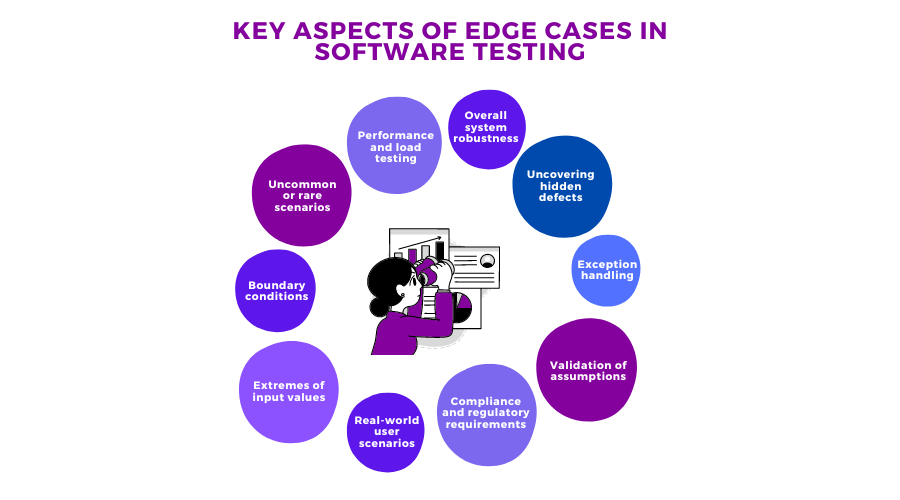
Have you ever encountered a situation where a product or service behaves unexpectedly and unusually? Perhaps it only happens once in a blue moon, but when it does, it leaves you scratching your head and wondering what happened.
That’s when you may have encountered an edge case.
An edge case is a scenario that falls outside the normal range of inputs, conditions, or parameters that a product or service handles. In other words, it’s a rare, unusual, or unforeseen situation.
Edge cases can cause problems, from minor annoyances to catastrophic failures.
Understanding edge cases is essential in many fields, including software development, user experience design, and product management. By identifying and testing for edge cases, teams can improve the reliability and usability of their products and services.
So, what exactly constitutes an edge case, and why are they so important? Let’s dive deeper into this topic and explore the meaning and overview of edge cases.
Meaning of Edge Case
Edge Case Definition:
In software development, an edge case denotes a bug or issue that developers do not anticipate affecting a significant number of users or devices. Instead, it is a problem that may only get encountered under unusual circumstances or by a small subset of users.
The design or development of a product or system often does not consider unexpected or rare scenarios, which you refer to as edge cases.
Such cases can cause problems or errors that can be difficult to diagnose and fix. Examples of edge cases can include, but are not limited to:
- User errors: Situations where users enter data or perform actions the system cannot handle. For instance, the design may not anticipate users entering invalid data or clicking buttons that they have not expected.
- Misuse: When users utilize the product in unintended ways, for example, using a CD drive as a cup holder.
- Dependencies: When a product depends on a resource that becomes unavailable or changes, such as an internet connection or a code library.
- Corner cases: When unlikely events co-occur to produce unexpected results, such as multiple users registering at the same time with the same name.
- Technological changes: When users try to use obsolete or innovative technology that the system cannot support.
Developers need to consider edge cases during the design and development process to minimize the risk of errors and ensure that the product can handle unexpected scenarios.

What Is an Edge Case in Programming?
An edge case in programming is a situation or input value that is not typical or common and may require special handling in a program algorithm. Developers must validate such cases through unit testing to ensure the program behaves correctly.
As per a StackOverflow post, testing a series of edge cases around each “boundary” can provide good coverage and confidence in the program’s behavior, assuming that if it works correctly at the edges, it should work correctly everywhere else.
To illustrate, consider a program that divides two numbers. Edge cases involve using very large or minimal numbers to check if the program works correctly at the extremes.
By testing these boundary conditions, developers can ensure that their program can handle a wide range of input values and circumstances, even those that may be unexpected or rare.
Considering edge cases while developing software is crucial because the program’s real-world use cases may differ from the developer’s intended.
Types of Edge Cases
The following are the different types of edge cases:
- Input Edge Cases: Testing the program with extreme input values, including very large or small numbers
- Hardware Edge Cases: Testing the program with uncommon hardware configurations or devices.
- Timing Edge Cases: Testing the program under unusual timing conditions, such as high loads or low network bandwidth.
- Configuration Edge Cases: Testing the program with unique settings or disabled features.
- Security Edge Cases: Testing the program under atypical security conditions, such as with different permissions or disabled security features.
Edge case vs Corner case
When it comes to programming, there are two terms that you might come across: corner cases and edge cases. These terms refer to scenarios outside of the usual usage of a software system.
Let’s start with edge cases.
An edge case is a unique condition that can cause a bug or system failure. For instance, a search engine might encounter an edge case when a user searches for a query with an enormous number of characters, which could cause the system to crash.
On the other hand, a corner case is a more complex type of edge case. It occurs when multiple unique conditions are involved. It pushes the system’s variables to their limits and puts users at the “corner” of a multidimensional configuration space.
To illustrate this, consider a software system that manages appointments if the system allows users to create appointments for a maximum of 24 hours. If a user tries to make an appointment for precisely 24 hours, that’s an edge case.
However, if a user attempts to create an appointment that lasts precisely 24 hours, starting at 11:59 PM and ending at 11:59 PM the following day, that’s a corner case.
Why are Edge Cases Important?
Edge cases, which refer to scenarios that fall outside the regular usage of a software system, are a crucial consideration for software developers. There are two main reasons why edge cases are important to consider:
Impact on User Experience
Users with a poor product experience are likely to stop using it. Edge cases often represent situations critical to a small subset of users. Suppose these users have a negative experience with the product due to an edge case scenario.
In that case, they may stop using the product and even share their negative experience with others. Ultimately, this could lead to a decline in the product’s overall user base and revenue.
Revealing Underlying Problems
Edge cases can reveal underlying issues or vulnerabilities in a software system that may not be apparent in normal usage scenarios.
These issues may become more pronounced when the system gets used in edge case scenarios. Identifying and addressing these problems can improve the overall quality and reliability of the software system.
To illustrate this point, let’s take a mobile application that allows users to upload photos.
Suppose the application needs to get optimized for edge cases such as low network bandwidth or large file sizes. In that case, users may have a poor experience and even uninstall the application.
Moreover, edge cases may reveal underlying problems, such as slow or inefficient algorithms for image processing.
By addressing these edge case scenarios, developers can enhance the overall quality and reliability of the application.
Edge Case and Product Team
When working on a software system, product teams need to consider edge cases, which are scenarios that fall outside the normal usage of the product. Ignoring these cases can have negative consequences, as discussed below.
Poor User Experience
Users with a bad experience with a product are likely to stop using it. Edge cases often represent scenarios important to a small subset of users.
Therefore, if these users have a poor experience with the product due to an edge case scenario, they may stop using it. Users can share their negative experiences with others.
Ultimately, this can harm the product’s overall user base and revenue.
Potential Security Vulnerabilities
Hackers make a habit of discovering edge cases and can exploit them to gain unauthorized access to a software system.
Ignoring edge cases can leave a system vulnerable to attacks that target these scenarios.
Developers can identify and address potential vulnerabilities before someone can exploit them by considering edge cases during the development process.
FAQs
Testers can find edge cases using creativity and critical thinking during any testing cycle, including regression and functional testing. It’s important to actively look for edge case defects at any point in the development cycle to ensure a more complete and reliable software system.
An edge case is a software bug that only affects a few users or devices or can only be reproduced under uncommon circumstances. Despite being specific, it doesn’t imply that the bug is hard to replicate.
